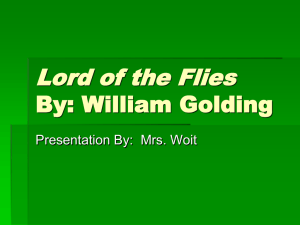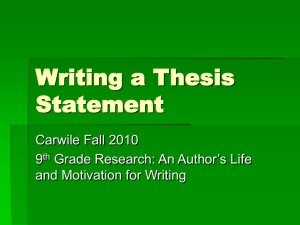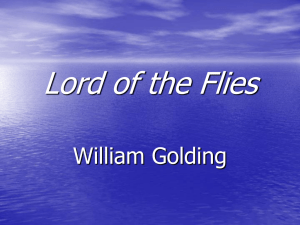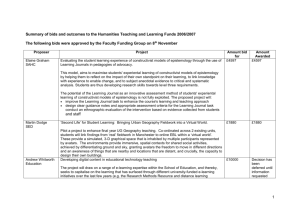Environmental Risk Decision Making
advertisement
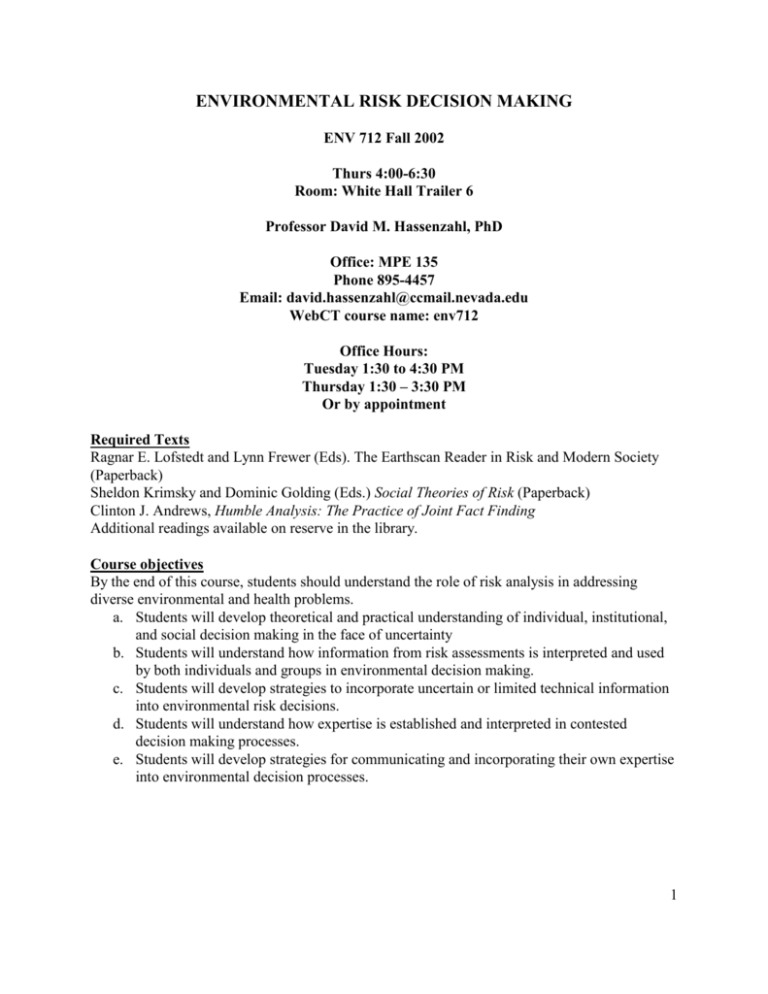
ENVIRONMENTAL RISK DECISION MAKING ENV 712 Fall 2002 Thurs 4:00-6:30 Room: White Hall Trailer 6 Professor David M. Hassenzahl, PhD Office: MPE 135 Phone 895-4457 Email: david.hassenzahl@ccmail.nevada.edu WebCT course name: env712 Office Hours: Tuesday 1:30 to 4:30 PM Thursday 1:30 – 3:30 PM Or by appointment Required Texts Ragnar E. Lofstedt and Lynn Frewer (Eds). The Earthscan Reader in Risk and Modern Society (Paperback) Sheldon Krimsky and Dominic Golding (Eds.) Social Theories of Risk (Paperback) Clinton J. Andrews, Humble Analysis: The Practice of Joint Fact Finding Additional readings available on reserve in the library. Course objectives By the end of this course, students should understand the role of risk analysis in addressing diverse environmental and health problems. a. Students will develop theoretical and practical understanding of individual, institutional, and social decision making in the face of uncertainty b. Students will understand how information from risk assessments is interpreted and used by both individuals and groups in environmental decision making. c. Students will develop strategies to incorporate uncertain or limited technical information into environmental risk decisions. d. Students will understand how expertise is established and interpreted in contested decision making processes. e. Students will develop strategies for communicating and incorporating their own expertise into environmental decision processes. 1 Class Schedule DATE 29-Aug 05-Sep 12-Sep TOPIC Part I: Introduction Topic: Defining risk Part II: Risk, Individuals and Society Conceiving risk from individual to cultural Individual interpretations of risk 19-Sep Risk and Society On-line discussion with Branden Johnson 25-Sep Risk and Culture 03-Oct Part III: Expertise and Experts Science and Risk Decisions On Line Discussion with Clint Andrews READINGS Lfstedt and Frewer, Introduction (Pages 3 – 27) DELIVERABLES None Kammen and Hassenzahl, Chapter One (Handout) Douglas, Mary “Risk as a Forensic Resource” from Daedalus special issue on Risk, 1990 (Reader) Renn, “Concepts of Risk” in Krimsky and Golding pages 53 – 79 Kahneman and Tversky Heuristics and Biases Slovic: The Psychometric Paradigm (Lfstedt and Frewer Pages 31-44) Slovic: Perception of Risk (Krimsky and Golding pages 117 – 152) Weinstein, ND “Optimistic Biases about Personal Risks (Lfstedt and Frewer Pages 239 – 244) Slovic, “Perceived Risk, Trust and Democracy” (Lfstedt and Frewer Pages 181-192) Kasperson et al “The Social Amplification of Risk” (Lfstedt and Frewer Pages 149 – 162) Johnson, B.B. “Gender and Race in Belief About Outdoor Air Pollution. Risk Analysis 22(4) 725-738. (In reader) Suggested: Kasperson The Social Amplification of Risk: Progress in Developing and Integrative Framework” (Krimsky and Golding pages 153 – 178) Rayner and Cantor, “How Fair is Safe Enough?” (Lfstedt and Frewer pages 91 – 100) Wildavsky and Dake, “Theories of Risk Perception: Who Fears What and Why? (Lfstedt and Frewer pages 101 – 114) Sjberg “Explaining Risk Perception: An Empirical Evaluation of Cultural Theory” (Lfstedt and Frewer pages 115 – 132) Sjberg, L and af Wahlberg, A “Risk Perception and New Age Beliefs” Risk Analysis 22(4) 751-764 (handout) Weinstein “Science and Tran-Science” (in reader) Shrader-Frechette, “Scientific Method, Anti-Foundationalism and Public Decision Making” (Lfstedt and Frewer Pages 45 – 56) Funtowicz and Ravetz: “Three Types of Risk Assessment and the Emergence of PostNormal Science” (Krimsky and Golding, 251 – 274) Andrews, Chapter 3 Discussion and response Discussion and response Short paper 1 due. Discussion and response Discussion and response Discussion and response Short paper 2 due. 2 DATE 10-Oct TOPIC Experts and Risk Decisions Possible Discussion with Rob Goble 17-Oct Risk, the media and Genetically Modified Organisms 24-Oct Comparing Risks 31-Oct Joint Decision Making Guest: Dr. Katie Purvis, Discussion with Tom Beierle 07-Nov Risk Communication 14-Nov Part IV: Decision Making READINGS Otway “Public Wisdom, Expert Fallibility: Toward a Contextual Theory of Risk” (Krimsky and Golding, 215 – 228) Freudenberg “Heuristics, Biases, and the not-so General Publics: Expertise and Error in the Assessment of Risks” (Krimsky and Golding, 229 – 250) Brown and Goble “The Role of Scientists in Risk Assessment” Access from WebCT. Jasanoff “Bridging the Two Cultures of Risk Analysis” (in reader) Frewer et al “What Determines Trust in Information about Food Related Risks?” (Lfstedt and Frewer pages 193 – 212) Frewer, L, Miles, S and Marsh, R. (2002). The Media and Genetically Modified Foods: Evidence in Support of Social Amplification of Risk (in reader) Anders A F Wahlberg, Lennart Sjoberg (2000). “Risk perception and the media” J. Risk Research 3(1) 31-50. (in reader) Tengs et al “500 Life-Saving Interventions and their Cost Effectiveness” Heinzerling “500 Life-Saving Interventions and their Misuse in the Regulatory Debate” Hassenzahl “Effects on Uncertainty on Cost-Effectiveness Estimation” (in reader) Andrews Chapters 1, 2, 6 – 11 Beierle, T (2002) “The Quality of Stakeholder-Based Decisions.” Risk Analysis 22(4) 739-750. (in reader) Fischoff “Risk Perception and Communication Unplugged: Twenty Years of Process” (Lfstedt and Frewer Pages 133 – 148) Lfstedt and Renn “The Brent Spar Controversy: An Example of Risk Communication Gone Wrong” (Lfstedt and Frewer Pages 245 – 252) Griffen, R. and Dunwoody, S (2000). “The Relation of Communication to Risk Judgment and Preventive Behavior Related to Lead in Tap Water.” Health Communication 12(1) 81 – 107 Flannery, Mary Ann (2000) “Risk Communication and the Reasonable Reader Concept” Journalism and Mass Communication Educator, Autumn 2000. Von Winterfeldt “Expert Knowledge and Public Values in Risk Management: The Role of Decision Analysis” (Krimsky and Golding, pp 321 – 342) Kunreuther “A Conceptual Framework for Managing Low-Probability Events (Krimsky and Golding, pp 301 – 320) Von Winterfeldt (1987). “Value Tree Analysis: An introduction and an Application to Offshore Oil-Drilling.” In Kleindorfer and Kunreuther, Eds Insuring and Managing Hazardous Risks: From Seveso to Bhopal and Beyond. Springer-Verlag New York. DELIVERABLES Discussion and response Discussion and response Term Paper Topic due Discussion and response Short Paper 3 due Discussion and response Term Paper Outline Due Discussion and response Discussion and response Short Paper 4 due 3 21-Nov Decision Making Exercise In-class exercises, followed by discussion 28-Nov No Class None 6-Dec Mental Models 12-Dec Final exam time meeting Jungerman, H. Schutz, H and Thuring, M (1998). Mental Models in Risk Assessment: Informing People About Drugs. In Lofstedt and Frewer Lazo, J. K, Kinnell, J, Bussa, T, Fisher, A. and Jablonski, R (1999). “Mental Models of Ecosystems”. Risk: Health, Safety and Environment 10(1) 45 – 64. None Discussion and response Term Paper Rough Draft Due Short Paper 5 due December 2 Prepare for game Term Paper! 4 Grading and requirements PLEASE SUBMIT ALL WRITTEN MATERIALS VIA WebCT. This syllabus is also available at the WebCT site Grading Grades are based on the number of points earned in class (out of 100 available) A 92-100, A- 90-91, B+ 88 – 89, B 82 – 87, B- 80 – 81, C+ 78 – 79, C 72 – 77, C- 70 – 71 D+ 68 – 69, D 60 – 67 F < 60 Grading is based on three components: participation (25 points), short papers/projects (30 points) and term paper (40 points). Participation (25 points) Attendance. Attendance at all sessions is essential to learning and therefore mandatory. If you must miss a session, you may negotiate alternative credit for that class session. You may not make up more than two sessions. Readings. Students are expected to do all readings prior to each class, and bring notes for their own reference during discussions. Discussion questions. Each student must submit a brief question for discussion to WebCT by noon on the day of class. This should be at minimum one paragraph: a sentence stating the question and several sentences supporting or developing the topic. Be prepared to lead a discussion of your question. Discussion Groups. We will have several opportunities during the semester to converse (via WebCT) with authors of some of the papers you will read. All students are expected to participate in these discussions—i.e. to present questions to be answered by other students or the author. This will take the place of discussion questions. Short papers (5 papers, 6 points each) Each student should turn in a one to two page (typed, double spaced, 12 point font, 1” margins) essay on the dates specified, for a total of 5 short papers. A list of essay topics will be posted at the WebCT site two weeks before each essay is due. See class calendar above or WebCT for paper due dates. Term paper (40 points) Each students should submit a 15 – 20 page term paper by the date of the final exam. Term papers will evaluate a current risk debate of the student’s choosing, and will evaluate the nature of the risk, its societal context, current understanding, and a discussion of the risk from perspectives gained in the course. Students are strongly encouraged to develop a thesis idea or chapter as a term paper. The paper should consider the following: The nature of the risk (causes or suspected causes, individuals at risk, associated societal and individual benefits) Societal context (acceptance, rejection, disagreement) Current understanding of the causes of the risk (sources of information, uncertainty and conflict) 5 Examples include biotech foods, human cloning, pesticide restrictions, high level or low-level radioactive waste management, cigarette bans, and international shipment of hazardous wastes. Note: The goal of this paper is not to take a stand on the issue and defend it. Rather, the goal is to explore why each side in the debate holds its positions, and understand the role of technical information and expertise in the debate. Deliverables (again, all should be submitted via WebCT) October 17: One or two paragraphs outlining the risk issue (2 points) October 31: Two page outline of the paper (3 points) November 21: Rough draft (5 points) December 12, 6 PM: Final draft (30 points) Note on grading: the 10 points for preliminary deliverables will be given in full, assuming adequate submittals (inadequate submittals will be returned to be redone). The final product will be graded based on quality—comprehensiveness, originality, and understanding. The final term paper must address all comments that I make on your earlier materials. Disabilities: If you have a documented disability that may require assistance, you will need to go to the Disability Resource Center (DRC) for coordination of academic accommodations. The Disability Resource Center is located in the Reynolds Student Services Building room 137. The DRC phone number is 895-0866 (TDD-895-0652) or drcssc@ccmail.nevada.edu. Copyright and fair use requirements The university requires each member of the University Community to become familiar with and follow copyright and fair use requirements. You are individually and solely responsible for violations of copyright and fair use laws. The University will neither protect nor defend you nor assume any responsibility for employee or student violations of copyright or fair use laws. Violations of copyright laws could subject you to federal and state civil penalties and criminal liabilities as well as disciplinary action under University policies. To help familiarize yourself with copyright and fair use policies, the University encourages you to visit its copyright web page at: http://www.unlv.edu/committees/copyright 6
